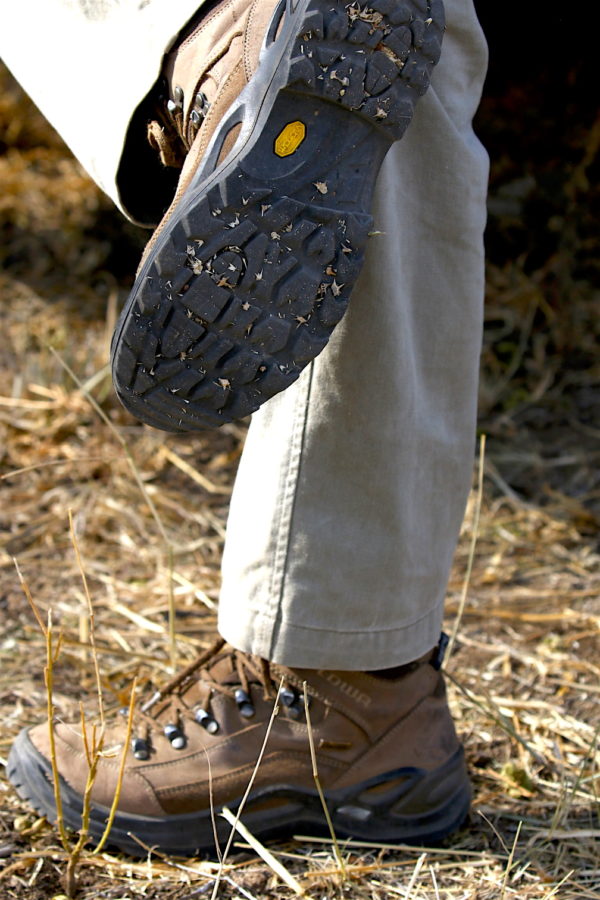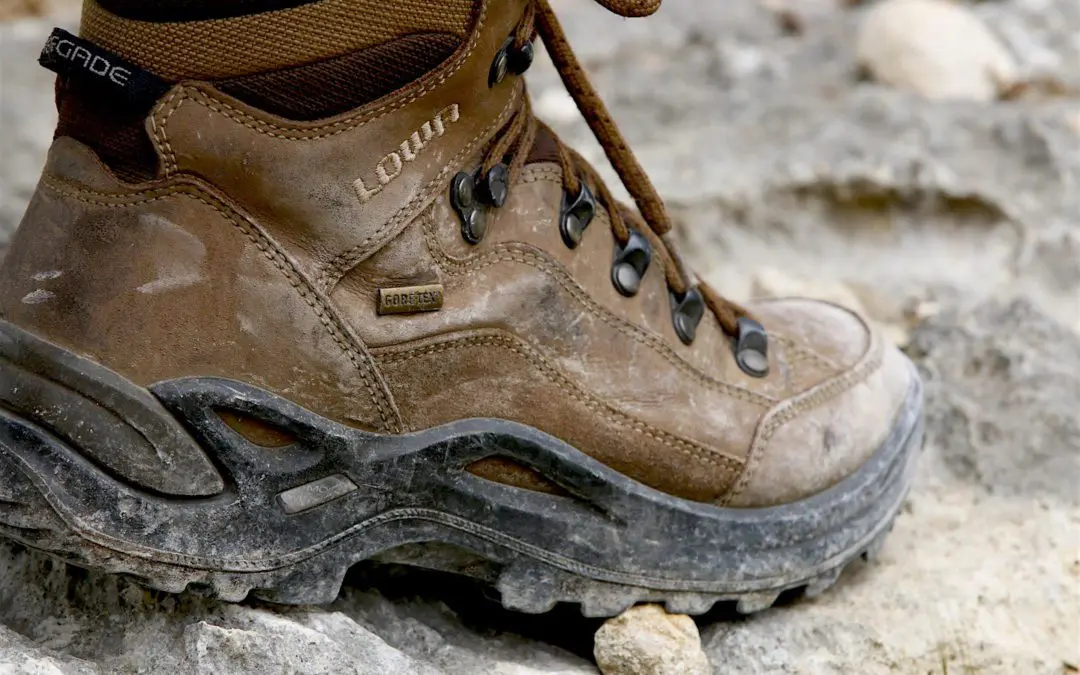The best African safari boots need to protect your feet from sharp stones and nail-tough thorns without blistering or scorching them. But that’s not all . . .
Most southern African safaris are conducted in dry, gravelly soils, often sand deserts. But some are run through thick thorn brush and a few in grassy hills and mountains similar to those of eastern Montana or Wyoming. In eastern South Africa you might even hunt in fairly loamy soils with a mix of grass, brush, and forest mixed with grain fields, sugar cane, and orchards. But nearly everywhere you will encounter a variety of thorns and sharp stones that can penetrate thin soles and sidewalls.
IDENTIFY HABITAT TO IDENTIFY YOUR BEST AFRICAN SAFARI BOOTS
When you book any hunt, ask your PH what kind of terrain (flat, hilly, mountainous), soils (dry, wet, sandy, rocky, muddy), and vegetation (grass, brush, forest, thorns) you’ll be traversing. That will largely determine which boots you’ll want to wear. Even though the continent of Africa has the highest average elevation in the world, much of its best hunting grounds are not in steep mountain terrain. Why wear stiff, heavy mountaineering boots if they aren’t needed?
Next, ask about temperatures. In general, southern Africa sees morning temperatures dip into the 40s, sometimes near freezing, and now and then below freezing. The higher you go and the farther south you hunt, the colder it could be. I was on one hunt with Crusader Safaris one July when the mercury fell into the single digits. The pipes froze in the farmhouse where we were lodging. That wasn’t sandals weather!
As a general rule, however, uninsulated boots are more than adequate. You can layer a good wool sock over a liner sock or even a medium-density cotton sock for cold mornings, then shed as necessary. More hunters seem to struggle with hot feet at midday than cold feet at any time. Your individual tolerance will dictate what you’ll need. Usually we are shedding jackets and hunting in shirtsleeves by mid-morning, noon at the latest.

Best African safari boot soles protect your feet against many painfully sharp thorns. Long pant cuffs help keep sand and stones out of shorter boots, too.
BEST AFRICAN SAFARI BOOTS FOR MOUNTAINOUS TERRAIN
If you’ll be hunting in the Hochlands (Highlands) of Namibia or any dry mountain ranges in South Africa, you’ll want good ankle support as well as a tough, fairly stiff sole or footbed with deep lugs for traction. The idea here is to minimize ankle twisting, provide a stiff footbed to minimize over-flexing, attack with a sharp-edged sole that can cut into steep hillsides, and grab onto small projections of rock to gain traction. A classic American/European-style hiking boot fits these requirements.
One I like is the LOWA Tibet LL with its stiff leather upper, deeply lugged outsole, glove leather lining, and high, protective rubber rand around the outsole/upper connection. This wide rand protects the leather uppers wonderfully against cuts and abrasion, which you get a lot of in dry desert rocks. The hard, Vibram, lugged sole of this boot is just right for fending off the long, stiff, tough thorns of the desert, too, while wrapping around small bumps and projections of rock for traction. A similar boot is Kenetrek’s Desert Guide. Notice that both of these boots minimize exposed stitching. In my experience, boots with lots of small sections of leather stitched together merely increase points at which the boot will fail. Stitching rots, tears, and frays. Look for boots that minimize exposed threads and “hide” it high and toward the back of the boot, where it is least likely to suffer abrasion.
Notice also that the uppers on these boots are not particularly high, perhaps six inches. This is borderline for allowing sand and small stones to fly up and into the boot as you hike. To minimize or prevent this, wear long pant cuffs to cover your boot uppers. Alternatively, buy boots with eight- to ten-inch uppers. These might be too hot for your tastes, in which case you can try light gaiters. Personally, I find eight-inch leather uppers cooler than gaiters, but both work.
BEST AFRICAN SAFARI BOOTS FOR FLAT TO ROLLING DESERTS
Flat to rolling sand deserts interspersed with boulders, stones, and occasional rock outcroppings are common across southern Africa. In these habitats, stiff soles, ankle support ,and abrasion resistance are much less important. Comfort may be your main concern. Africans typically wear light, uninsulated, all-leather, chuka-style boots with short uppers. Some just wear sandals, which I think is silly. They are forever stopping to remove stones and sometimes thorns. Maybe I’m an American wuss, but I’ll stick with leather boots offering more protection.
During my last two safaris, I wore LOWA Zephyr Desert Mid TF boots with great success. Light, uninsulated, and flexible, they seem to make walking easy with a natural, rolling gait. The soles proved thick enough to turn all thorns (and there are some massive ones there), yet their lugs had enough depth to cling nicely to exposed rock kopjes (rocky hills).
Zephyrs have some breathable nylon on the uppers and considerable stitching, so they aren’t as durable as the stiffer mountain boots described above, but they include a unique “monowrap” exoskeleton of some kind of stiff polymer that acts like a basket or cradle. This wraps up the side of the boot to provide lateral stability with minimum weight. It also seems to protect the leather and nylon from stones and other abrasive junk. These will eventually tear, crack, or pull away from the leather, I should guess, but so far so good.
A boot recently recommended by a friend with some military experience is the Belleville TR513 Flyweight Coyote Desert boot. I guess Belleville boots are relatively inexpensive yet quite popular with our soldiers working in those hot Middle East deserts, suggesting it should be more than good enough for a one- or two-week African desert safari. The eight-inch uppers are nylon edged in leather. There’s no stitching across the toe, and the outsole looks moderately aggressive. Cushioned midsole, removable insole, and ventilation holes on the side suggest this is, indeed, a boot designed for hot deserts.

African guides tend to like relatively simple, low, chuka-style boots, but I find they let too much debris fall inside.
BEST AFRICAN SAFARI BOOTS FOR SWAMPS AND RIVERS
Yes, there are a few swamps and rivers in southern Africa. If you pursue buffalo, hippo, crocodile, lechwe, or sitatunga, you’ll likely be near or in water. Ask your PH what he recommends. I’ve gone in with just cheap, canvas tennis shoes and once with U.S.-style river sandals, but potential parasites and diseases in some waters suggest hip boots or armpit waders.
If you need to go to that extreme, try lightweight Gore-Tex waders. They really work! The most durable I’ve worn are Simms. Trust me, they aren’t cheap! If you’re budget insists on something less spendy, try these Hodgman’s.
SOCK IT TO THOSE BOOTS
You can enhance or ruin boot performance with your socks. Some folks can pull on any old sock and function just fine, but many of us have to be persnickety in order to prevent blisters, overheating, or just plain discomfort. I have friends who’ll change into dry socks two or three times a day as they hunt. Keeps them stepping lively. Trust me, Merino wool hasn’t the itch of ordinary wool, and its ability to absorb moisture while offering good padding and insulation is impressive. Funny thing is, with wool socks my tootsies stay both cool when it’s hot and vice versa. Well-designed-and-built wool socks are more expensive than cotton, but they don’t seem to get all soggy—and their durability is impressive. I’ve got functional wool socks that have been with me longer than my dog, and she’s 14 this year.
BREAK YOUR BEST AFRICAN SAFARI BOOTS IN EARLY
Whichever boots and socks you select for your safari, get them early enough that you can thoroughly break them in before you find yourself marching miles in the sands. An army marches on its stomach, but safari hunters march in their boots.
For more from Ron Spomer, visit his website, ronspomeroutdoors.com, and be sure to subscribe to Sporting Classics for his rifles column and features.

